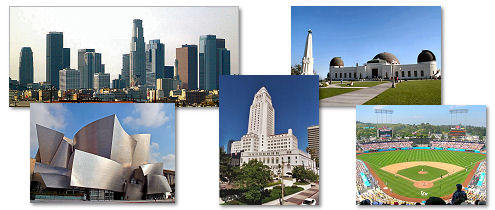
City Maps/Weather
| Fun City Facts The Mall of America in Bloomington, Minnesota is over 9.5 million square feet, or the size of 78 football fields. The top of the Empire State Building in New York was buit to be a mooring place for dirigibles (Blimps). |
|
|
||||||||
Los Angeles, California
City History |
||||||||
 The Los Angeles coastal area was inhabited by the earlier Native American nations for thousands of years. The first Europeans to arrive came in 1542 who claimed the area as the City of God for the Spanish Empire but did not stay. The next contact came 227 years later when Gaspar de Portolà, together with Franciscan padre Juan Crespi, reached the present site of Los Angeles on August 2, 1769. In 1771 the Mission San Gabriel Arcángel was built near what is now called San Gabriel Valley. On September 4, 1781, a group of 52 settlers from New Spain, which were predominantly of African descent, set out from the San Gabriel mission to establish a settlement along the banks of what is now called the Los Angeles River. The new governor of California recommended to the viceroy of New Spain that the site be developed into a town. In 1781 the town was founded and was named "El Pueblo de Nuestra Señora la Reina de los Ángeles del Río de Porciúncula," ("The Town of Our Lady the Queen of the Angels on the River".) It remained a small ranch town for decades, but by 1820 the population had increased to about 650 residents, making it the largest civilian community in Spanish California. New Spain achieved its independence from the Spanish Empire in 1821, and the town continued as a part of Mexico. Mexican rule ended during the Mexican-American War, when Americans took control from the Californios, on January 13, 1847 the war ended in California. Later, the Mexican government formally ceded Alta California and other territories to the United States. Europeans and Americans solidified control over the city during the California Gold Rush and secured the subsequent admission of California into the United States in 1850. The old city plaza railroads arrived when the Southern Pacific completed its line to Los Angeles in 1876. Oil was discovered in 1892, and by 1923 Los Angeles was supplying one-quarter of the world's petroleum. In the 1920s the motion picture and aviation industries both flocked to Los Angeles and helped with its further development. The city was the proud host of the 1932 Summer Olympics. In 1969, Los Angeles was one of two birthplaces of the Internet, as the first ARPANET transmission was sent from UCLA to SRI in Menlo Park. |
Historic Figures
Felipe de Neve (1728-1784)| Felipe de Neve (1728-1784) | |
| Governor de Neve was largely responsible for the establishment of the pueblo that has today become the city of Los Angeles. And, he is credited with being one of the first urban planners as he personally drew up the plans for the pueblo before actually establishing it. | |
browse cities | search | get listed | spotlight | about us | contact us | policies | partners
Copyright ©2025 www.ByCityLight.com - Page Design by Erik Schubach and Tristan Chambers